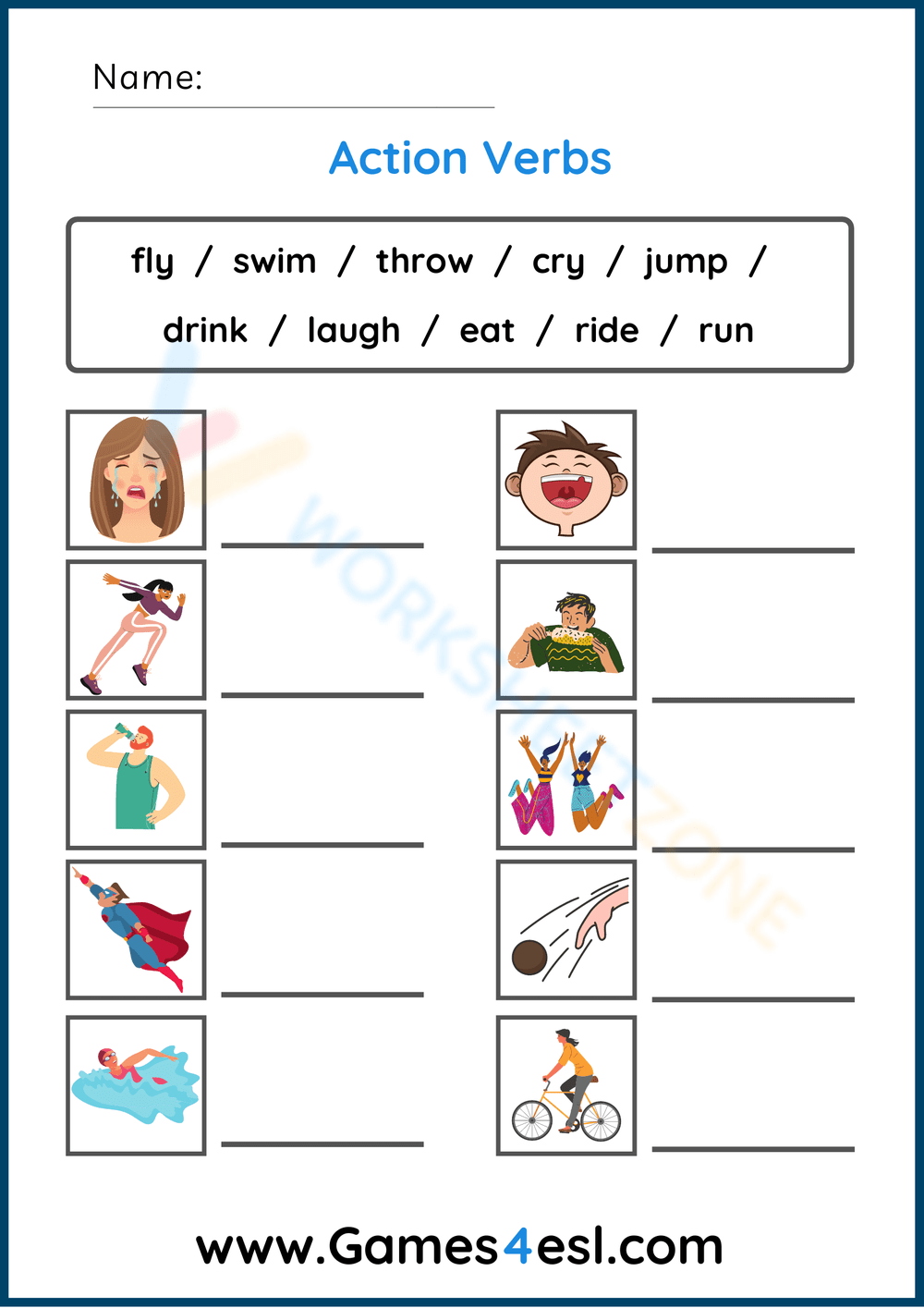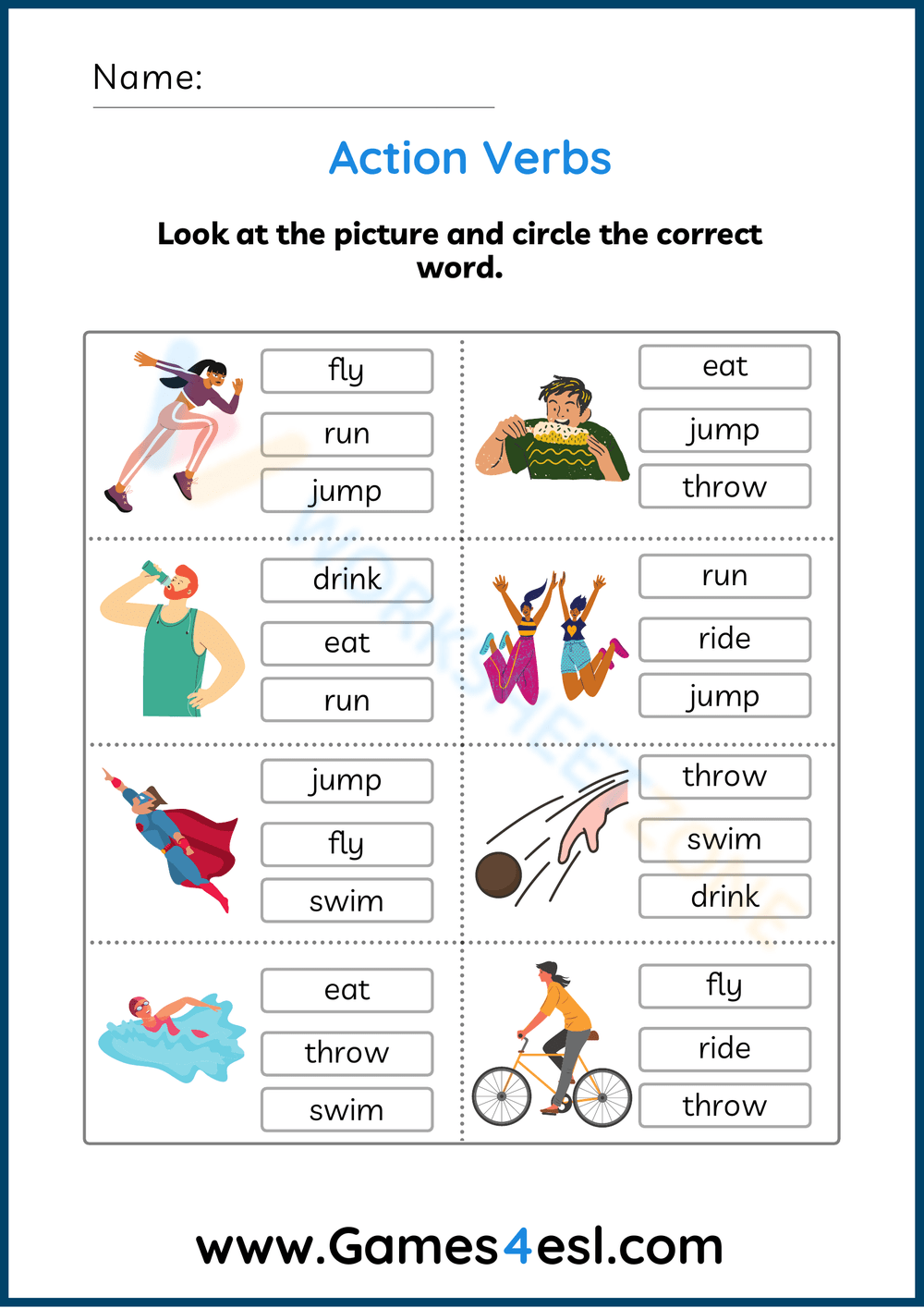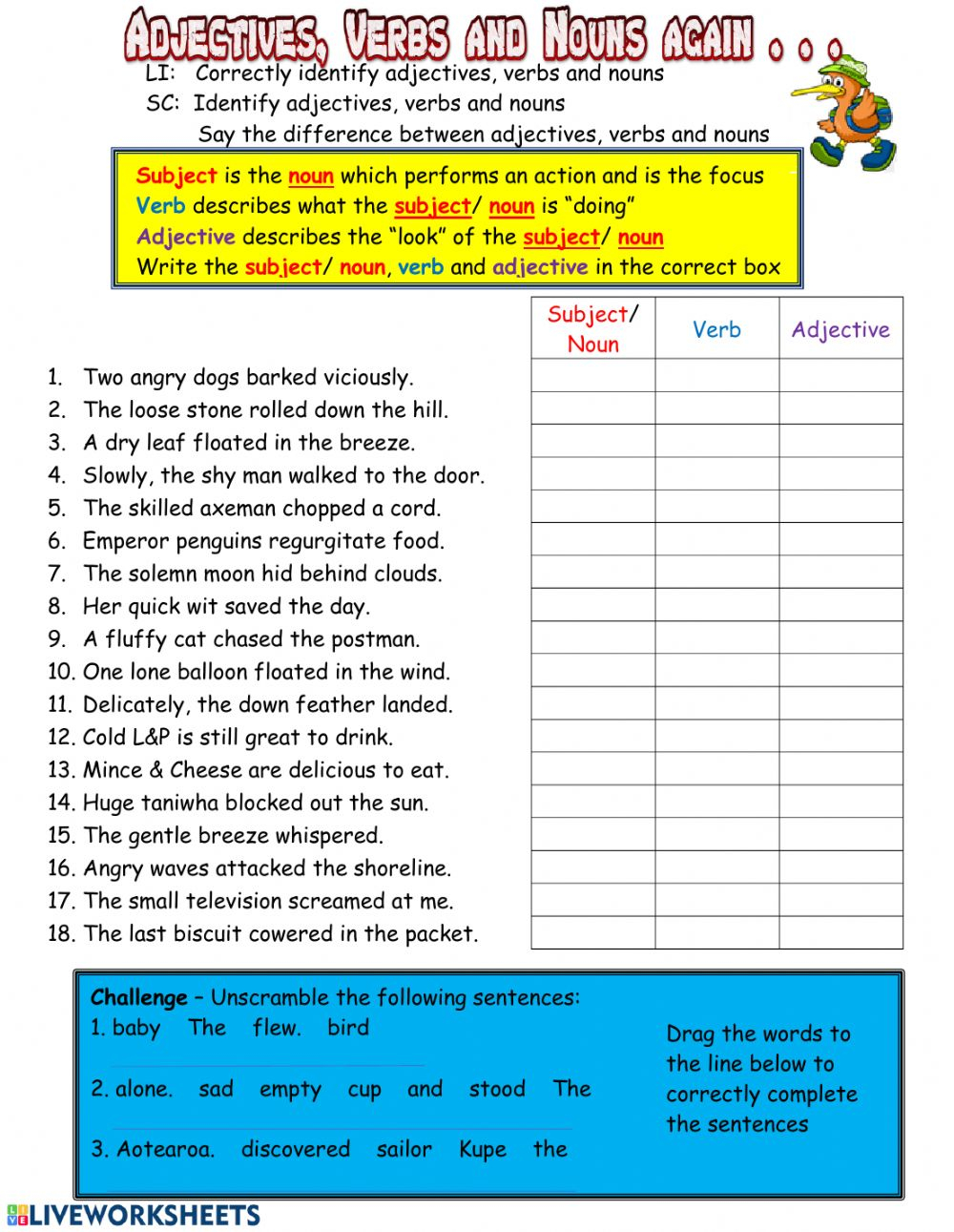
Mastering Language: The Indispensable Role of an Action Verbs and Adjectives Worksheet
In the vast and intricate landscape of language, precision and vividness are the hallmarks of effective communication. Whether crafting a compelling narrative, delivering a persuasive speech, or simply engaging in a meaningful conversation, the words we choose profoundly impact the clarity and impact of our message. At the very core of this linguistic mastery lie two fundamental parts of speech: action verbs and adjectives. Action verbs inject dynamism and movement, painting a picture of what is happening, while adjectives add color, detail, and nuance, bringing subjects and objects to life. To truly harness the power of these linguistic tools, learners often benefit from structured practice, and this is precisely where an action verbs and adjectives worksheet becomes an indispensable resource.
This article will delve into the profound importance of understanding and utilizing action verbs and adjectives, explore the multifaceted benefits of a well-designed worksheet, provide insights into creating effective exercises, and discuss how such a tool can significantly enhance language proficiency for learners of all ages and levels.
The Cornerstones of Expression: Action Verbs and Adjectives

Before we explore the utility of a specialized worksheet, it’s crucial to solidify our understanding of these two powerful components of speech.

Action Verbs: The Engines of Sentences

An action verb, as its name suggests, expresses an action, whether physical or mental. It tells us what the subject of the sentence does. Without action verbs, sentences would be static, lacking direction and energy.
Examples of Action Verbs:

- Physical Actions: run, jump, eat, write, build, sing, dance, explore, climb, throw, catch, swim, paint, cook.
- Mental Actions: think, believe, consider, dream, imagine, remember, understand, decide, analyze, ponder, recognize.
The careful selection of an action verb can dramatically alter the tone and meaning of a sentence. Consider the difference between "He walked quickly" and "He raced down the street." While both convey movement, "raced" imparts a sense of urgency and speed that "walked" does not. Mastering action verbs allows writers and speakers to be precise, energetic, and engaging, moving their narratives forward with purpose.

Adjectives: The Artists of Description
Adjectives are words that describe or modify nouns and pronouns. They answer questions like "which one?", "what kind?", or "how many?". Adjectives are the descriptive elements that add layers of detail, helping the audience visualize, feel, and understand the subjects more deeply.

Examples of Adjectives:
- Describing Qualities: beautiful, tall, soft, rough, brave, kind, intelligent, ancient, modern, vibrant, dull, mysterious.
- Describing Quantities: many, few, several, some, most, one, two, first, last.
- Describing States: happy, sad, angry, tired, excited, calm, nervous, peaceful.


Just as with action verbs, the choice of adjective can profoundly impact perception. Instead of saying "The house was old," consider "The house was dilapidated," "The house was ancient," or "The house was quaint." Each adjective evokes a different image and feeling. Adjectives breathe life into nouns, transforming bland statements into vivid descriptions.
The Synergy: How Action Verbs and Adjectives Work Together
The true magic happens when action verbs and adjectives are used in conjunction. They complement each other, creating a richer, more dynamic tapestry of language. An action verb sets the scene, and adjectives fill in the sensory details.
Examples of Synergy:
- "The brave knight valiantly fought the fierce dragon." (Adjective: brave, fierce; Action Verb: fought, valiantly – adverb modifying verb)
- "The sparkling river glistened under the bright sun." (Adjective: sparkling, bright; Action Verb: glistened)
- "The hungry child eagerly devoured the delicious meal." (Adjective: hungry, delicious; Action Verb: devoured, eagerly – adverb modifying verb)
By understanding this symbiotic relationship, learners can elevate their communication from merely functional to truly artful. This is precisely the skill an action verbs and adjectives worksheet aims to cultivate.
The Purpose and Benefits of an Action Verbs and Adjectives Worksheet
An action verbs and adjectives worksheet is more than just a list of words or simple fill-in-the-blanks. It is a structured pedagogical tool designed to reinforce understanding, encourage application, and solidify the knowledge of these crucial parts of speech. Its benefits are numerous and far-reaching:
- Reinforces Core Concepts: Worksheets provide repetitive exposure and practice, which is essential for cementing grammatical rules and vocabulary into long-term memory.
- Develops Identification Skills: Exercises often require learners to identify action verbs and adjectives within sentences or passages, honing their ability to recognize these parts of speech in context.
- Enhances Application Skills: Beyond identification, worksheets prompt learners to use these words correctly in their own sentences, fostering creative and accurate application.
- Expands Vocabulary: By encountering a variety of action verbs and adjectives in different contexts, learners naturally expand their lexicon. A well-designed worksheet can introduce synonyms and antonyms, enriching their word choices.
- Improves Sentence Structure and Fluency: Consciously working with verbs and adjectives helps learners build more complex, nuanced, and grammatically correct sentences, leading to greater overall fluency in both written and spoken language.
- Boosts Descriptive Writing: The focus on vivid language directly translates into improved descriptive writing abilities, allowing students to paint clearer pictures with their words.
- Fosters Critical Thinking about Language: Analyzing sentences to choose the most appropriate verb or adjective encourages learners to think critically about word choice and its impact on meaning and tone.
- Provides Measurable Progress: Worksheets offer a tangible way for both learners and educators to track progress and identify areas that may require further attention.
Designing an Effective Action Verbs and Adjectives Worksheet
The effectiveness of an action verbs and adjectives worksheet hinges on its design and the variety of exercises it offers. A good worksheet moves beyond simple rote memorization, encouraging deeper engagement and critical application.
Here are key elements and types of exercises to include:
-
Identification Exercises:
- Underline/Circle: Provide sentences or short paragraphs and instruct learners to underline all action verbs and circle all adjectives.
- Color-Coding: Assign different colors for verbs and adjectives (e.g., green for verbs, blue for adjectives) to make identification visual and engaging.
-
Matching Exercises:
- Verb to Noun/Adjective to Noun: Match action verbs to nouns they might describe (e.g., roar – lion) or adjectives to nouns they modify (e.g., fluffy – cloud).
- Synonyms/Antonyms: Match action verbs to their synonyms or antonyms, or do the same for adjectives, building vocabulary.
-
Fill-in-the-Blanks:
- Contextual Choice: Provide sentences with blanks and a word bank of action verbs and adjectives. Learners choose the most appropriate word to complete the sentence, considering context.
- Open-Ended: Provide sentences with blanks and encourage learners to fill them with any action verb or adjective that makes sense, fostering creativity.
-
Sentence Construction/Transformation:
- Using Given Words: Provide a list of action verbs and adjectives and instruct learners to create their own sentences using at least one of each.
- Adding Detail: Give simple sentences (e.g., "The dog barked.") and ask learners to add an adjective to describe the dog and an adjective/adverb to describe how it barked (e.g., "The small dog loudly barked.").
- Rewriting for Impact: Present a bland sentence and challenge learners to rewrite it using more vivid action verbs and descriptive adjectives.
-
Descriptive Writing Prompts:
- Picture Description: Provide an image and ask learners to write a short paragraph describing it, focusing on using a variety of action verbs and adjectives.
- Sensory Details: Ask learners to describe a familiar object or place using all five senses, emphasizing the use of descriptive adjectives and verbs related to sensory actions.
- Story Starters: Provide the beginning of a story and encourage learners to continue it, focusing on descriptive language.
-
Error Correction:
- Present sentences with misused or poorly chosen action verbs or adjectives and ask learners to identify and correct them.
Key Design Principles:
- Gradual Difficulty: Start with simpler identification tasks and progress to more complex application and creative writing exercises.
- Clear Instructions: Ensure instructions are concise, unambiguous, and easy to follow.
- Engaging Content: Use relatable scenarios, interesting themes, or even humor to keep learners motivated.
- Visual Appeal: Incorporate appropriate graphics or a clean layout to make the worksheet inviting.
- Answer Key: For self-assessment or teacher use, an answer key is invaluable.
Implementing and Leveraging the Worksheet
Once designed, an action verbs and adjectives worksheet can be used in various educational settings:
- Classroom Instruction: As a warm-up activity, a main lesson component, group work, or homework assignment.
- Homeschooling: A core resource for parents teaching language arts.
- Self-Study: An excellent tool for independent learners looking to improve their writing and speaking.
- Remedial Support: For learners struggling with basic grammar and descriptive language.
- ESL/EFL Learning: Crucial for non-native speakers to build a strong foundation in English.
After completing the worksheet, it’s vital to provide constructive feedback. Discussing answers, explaining reasoning, and encouraging peer review can deepen understanding and correct misconceptions. The worksheet should not be seen as an end in itself, but rather as a stepping stone to more confident and expressive communication.
Beyond the Worksheet: Sustaining Language Mastery
While an action verbs and adjectives worksheet is a powerful tool, mastering language is an ongoing journey. To sustain and expand the skills gained from worksheet practice, learners should also:
- Read Widely: Exposure to diverse texts naturally introduces new vocabulary and demonstrates how skilled writers use verbs and adjectives effectively.
- Engage in Creative Writing: Regularly practicing descriptive writing, journaling, or storytelling provides a low-stakes environment to experiment with new words.
- Practice Speaking: Consciously try to use more descriptive language in everyday conversations.
- Analyze Media: Pay attention to how authors, journalists, and even advertisers use verbs and adjectives to evoke specific emotions or create particular impressions.
- Play Language Games: Word games, vocabulary apps, and online quizzes can make learning fun and interactive.
Conclusion
The ability to communicate with precision, clarity, and vibrancy is a cornerstone of success in all aspects of life. At the heart of this ability lies a nuanced understanding and skillful application of action verbs and adjectives. An action verbs and adjectives worksheet, when thoughtfully designed and effectively utilized, serves as an invaluable pedagogical tool, guiding learners through the process of identifying, understanding, and ultimately mastering these essential linguistic components. By providing structured practice, fostering vocabulary growth, and encouraging creative expression, such a worksheet empowers individuals to transform their language from merely functional to truly impactful, unlocking a world of expressive possibilities. As learners progress, the skills honed through these targeted exercises will manifest in richer narratives, more persuasive arguments, and ultimately, more profound connections through the power of words.

